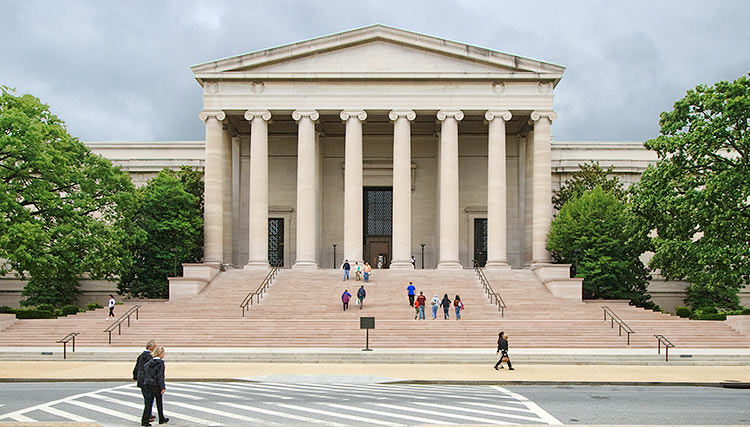THE URBAN SCENE: 1920–1950
On view through August 6, 2017
NATIONAL GALLERY OF ART
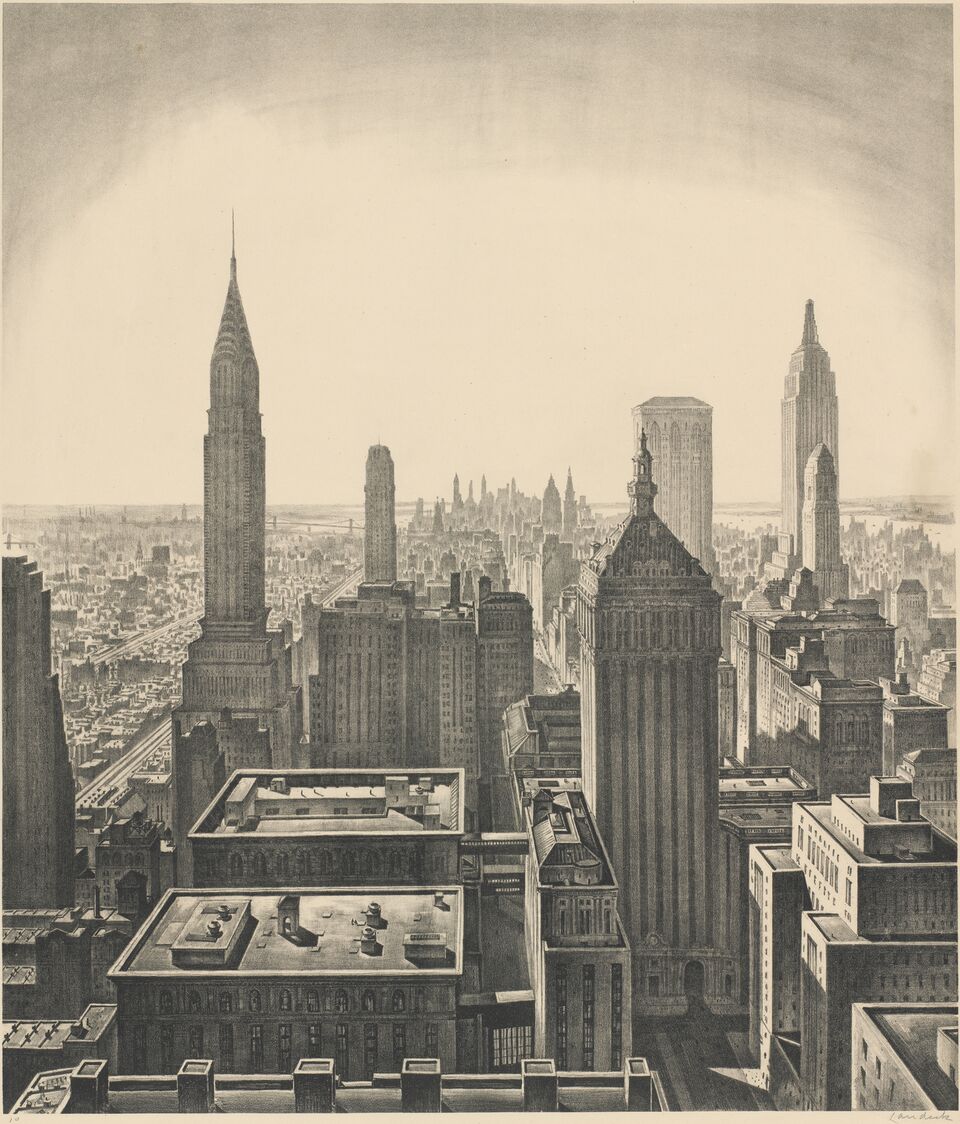 Armin Landeck,” View of New York”, 1932, lithograph, image: 68.9 x 59.7 cm (27 1/8 x 23 1/2 in.) sheet: 80 x 64.1 cm (31 1/2 x 25 1/4 in.) National Gallery of Art, Washington, Reba and Dave Williams Collection, Gift of Reba and Dave Williams
Armin Landeck,” View of New York”, 1932, lithograph, image: 68.9 x 59.7 cm (27 1/8 x 23 1/2 in.) sheet: 80 x 64.1 cm (31 1/2 x 25 1/4 in.) National Gallery of Art, Washington, Reba and Dave Williams Collection, Gift of Reba and Dave Williams
American artists of the early 20th century sought to interpret the beauty,
power, and anxiety of the modern age in diverse ways
Exhibition Highlights
The black-and-white prints that comprise The Urban Scene, often highlight the unprecedented scale of urban architecture and the impact of industry and technology on city life.
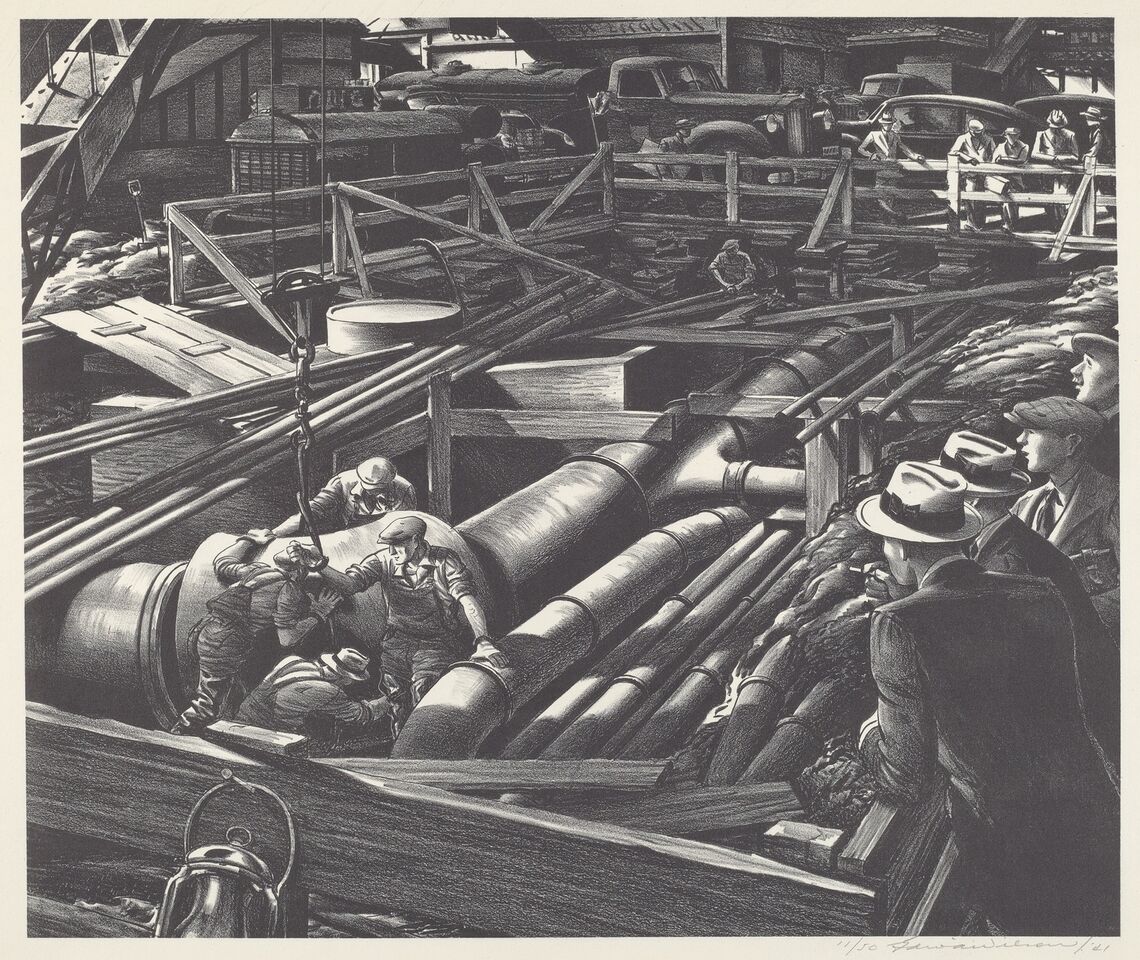 Edward Arthur Wilson, “Untitled” (Laying Pipe in New York City), 1941, lithograph, image: 27.94 x 33.02 cm (11 x 13 in.) sheet: 34.29 x 48.9 cm (13 1/2 x 19 1/4 in.) National Gallery of Art, Washington, Reba and Dave Williams Collection, Gift of Reba and Dave Williams
Edward Arthur Wilson, “Untitled” (Laying Pipe in New York City), 1941, lithograph, image: 27.94 x 33.02 cm (11 x 13 in.) sheet: 34.29 x 48.9 cm (13 1/2 x 19 1/4 in.) National Gallery of Art, Washington, Reba and Dave Williams Collection, Gift of Reba and Dave Williams
From one perspective, skyscrapers, bridges, and other technological marvels projected wealth, opportunity, and invoked the sublime, but from another these structures could be interpreted as blocking light, deepening shadows, heightening a sense of enclosure and confinement, and amplifying feelings of diminution and anonymity.
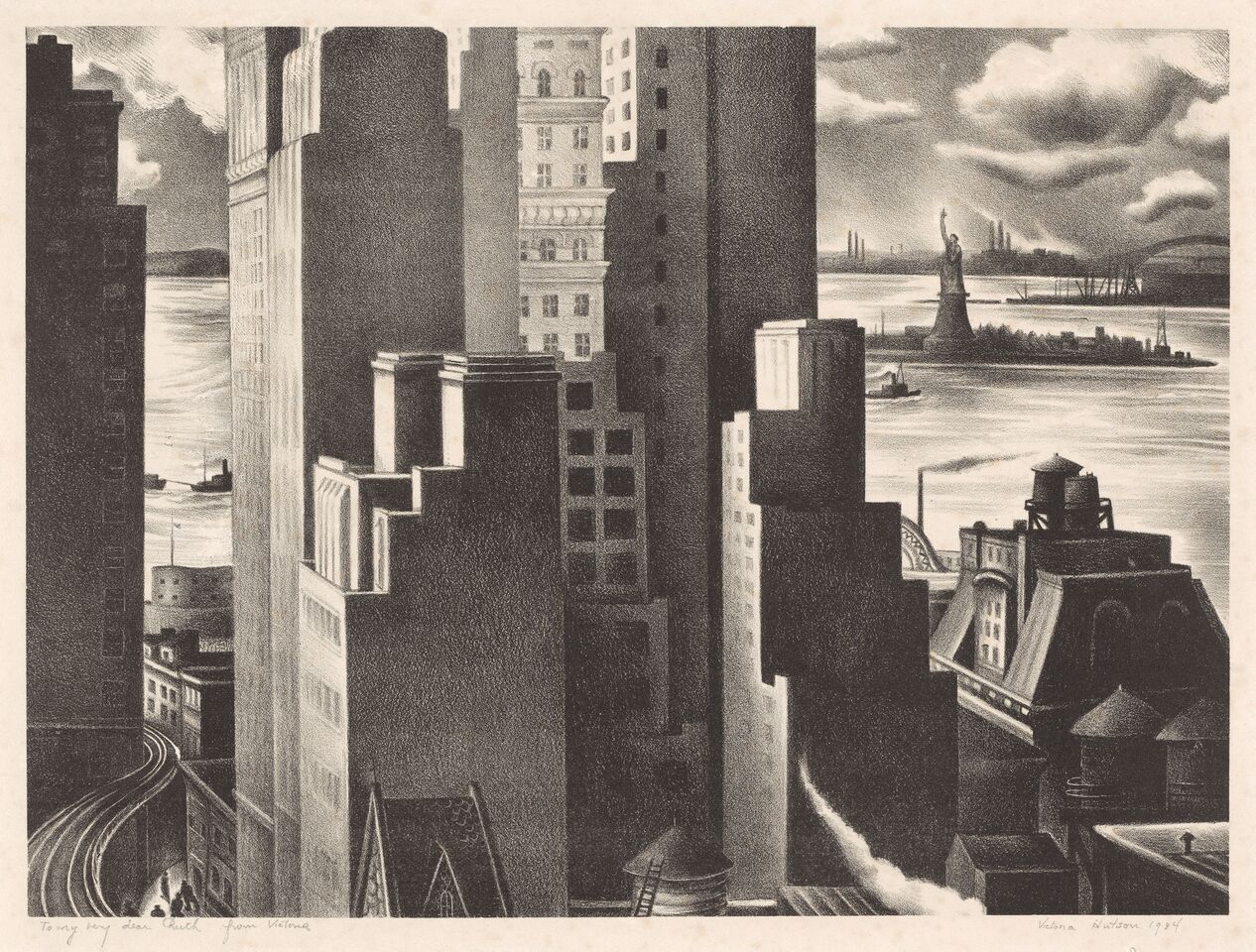 Victoria Hutson Huntley, “Lower New York”, 1934, lithograph, plate: 17.3 x 22.5 cm (6 13/16 x 8 7/8 in.) sheet: 33.3 x 36 cm (13 1/8 x 14 3/16 in.) National Gallery of Art, Washington, Gift of Bob Stana and Tom Judy
Victoria Hutson Huntley, “Lower New York”, 1934, lithograph, plate: 17.3 x 22.5 cm (6 13/16 x 8 7/8 in.) sheet: 33.3 x 36 cm (13 1/8 x 14 3/16 in.) National Gallery of Art, Washington, Gift of Bob Stana and Tom Judy
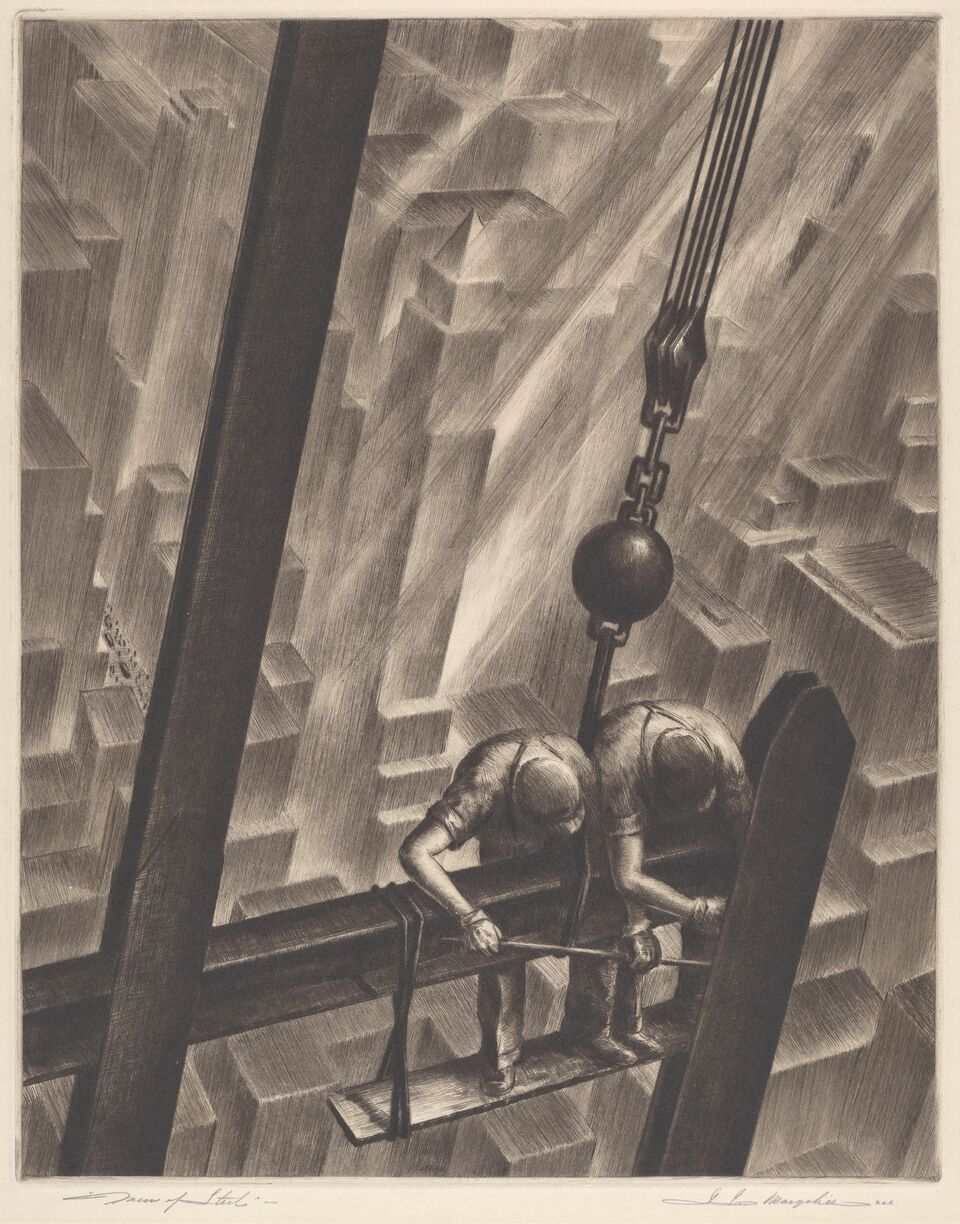 Samuel L. Margolies, “Men of Steel”, c. 1939, drypoint, plate: 38.1 x 29.85 cm (15 x 11 3/4 in.) sheet: 47.63 x 37.47 cm (18 3/4 x 14 3/4 in.) National Gallery
Samuel L. Margolies, “Men of Steel”, c. 1939, drypoint, plate: 38.1 x 29.85 cm (15 x 11 3/4 in.) sheet: 47.63 x 37.47 cm (18 3/4 x 14 3/4 in.) National Gallery
They used line to capture the specifics of a face or the idiosyncrasies of a building and manipulated tone to mimic the play of light. Employing precise detail and descriptive clarity to characterize experience, suggest meaning, and convey a narrative, certain elements were emphasized while others were minimized, resulting in images distilled to their narrative or atmospheric essence.
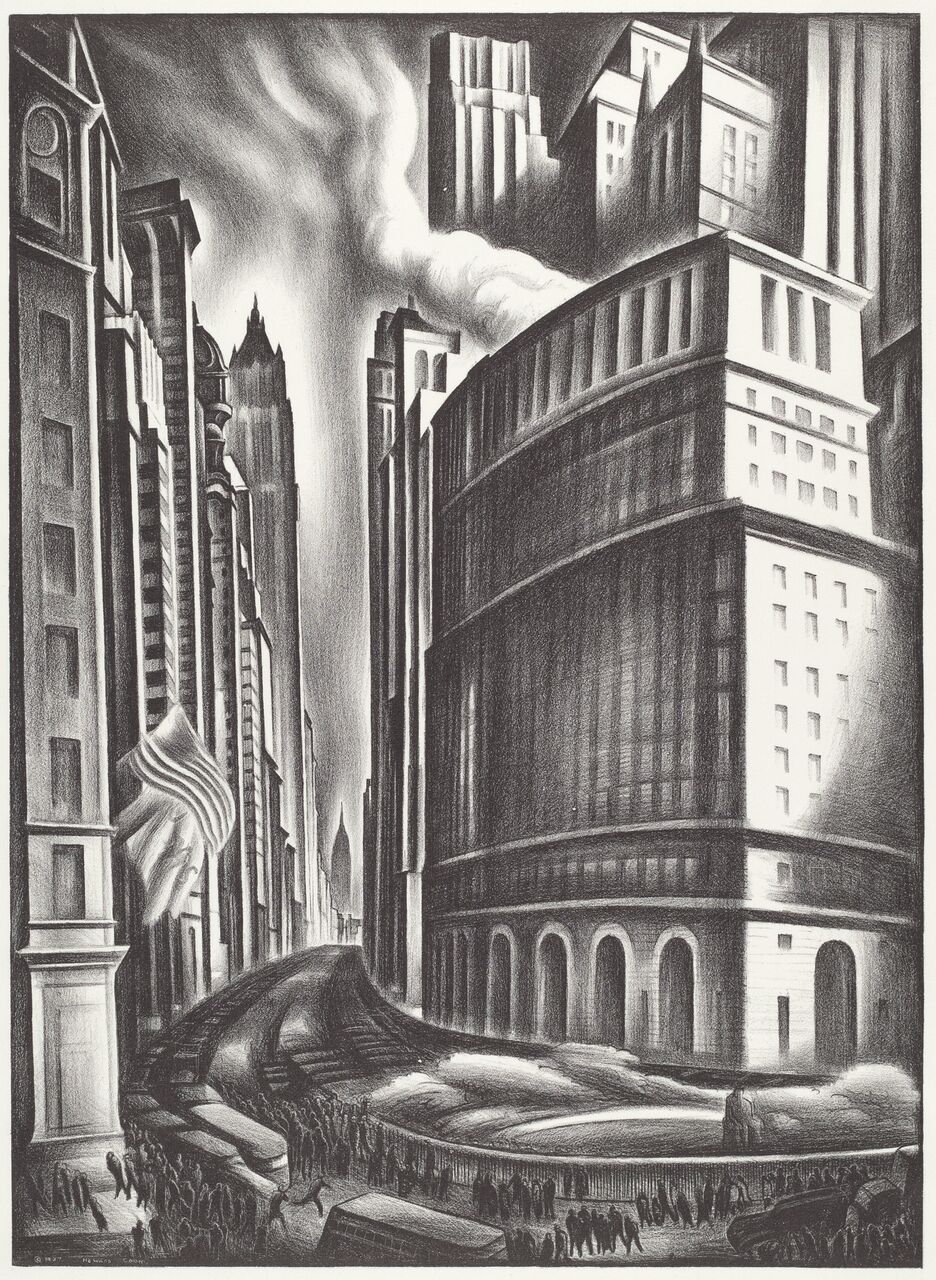 Howard Cook, “Looking up Broadway”, 1937, lithograph, image: 33.02 x 24.13 cm (13 x 9 1/2 in.) sheet: 45.4 x 31.75 cm (17 7/8 x 12 1/2 in.) National
Howard Cook, “Looking up Broadway”, 1937, lithograph, image: 33.02 x 24.13 cm (13 x 9 1/2 in.) sheet: 45.4 x 31.75 cm (17 7/8 x 12 1/2 in.) National
 Stow Wengenroth, “Quiet Hour”, 1947, lithograph, image: 8 3/4 x 15 in. (22.23 x 38.1 cm) sheet: 11 1/16 x 17 11/16 in. (28.1 x 44.93 cm) National Gallery of Art, Washington, Corcoran Collection (Bequest of Frank B. Bristow)
Stow Wengenroth, “Quiet Hour”, 1947, lithograph, image: 8 3/4 x 15 in. (22.23 x 38.1 cm) sheet: 11 1/16 x 17 11/16 in. (28.1 x 44.93 cm) National Gallery of Art, Washington, Corcoran Collection (Bequest of Frank B. Bristow)
The artists also scrutinized details to convey
particular aspects of urban life
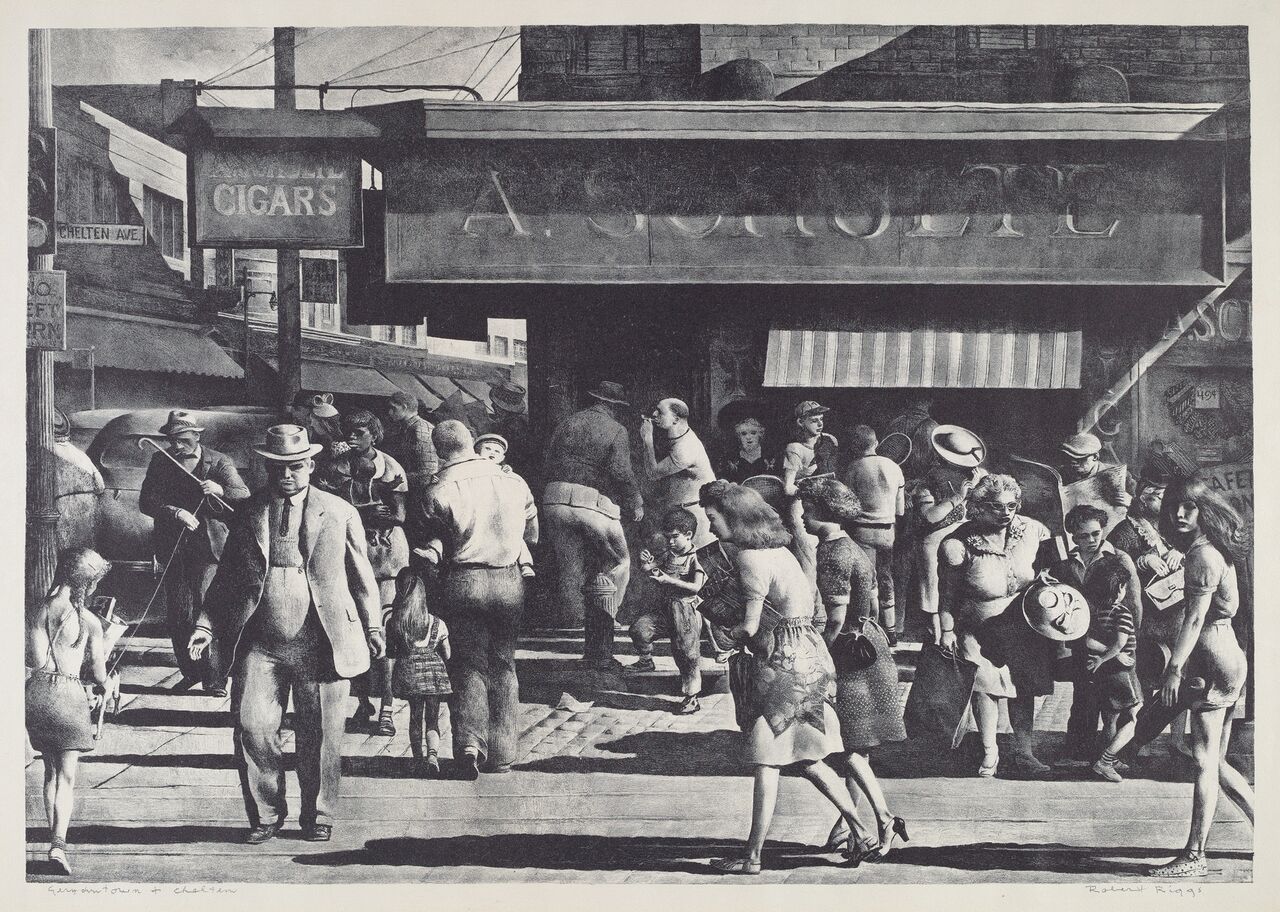 Robert Riggs, “Germantown & Chelten”, c. 1950, lithograph, image: 35.56 x 51.12 cm (14 x 20 1/8 in.) sheet: 40.64 x 58.1 cm (16 x 22 7/8 in.) National Gallery of Art, Washington, Reba and Dave Williams Collection, Florian Carr Fund and Gift of the Print Research Foundation
Robert Riggs, “Germantown & Chelten”, c. 1950, lithograph, image: 35.56 x 51.12 cm (14 x 20 1/8 in.) sheet: 40.64 x 58.1 cm (16 x 22 7/8 in.) National Gallery of Art, Washington, Reba and Dave Williams Collection, Florian Carr Fund and Gift of the Print Research Foundation
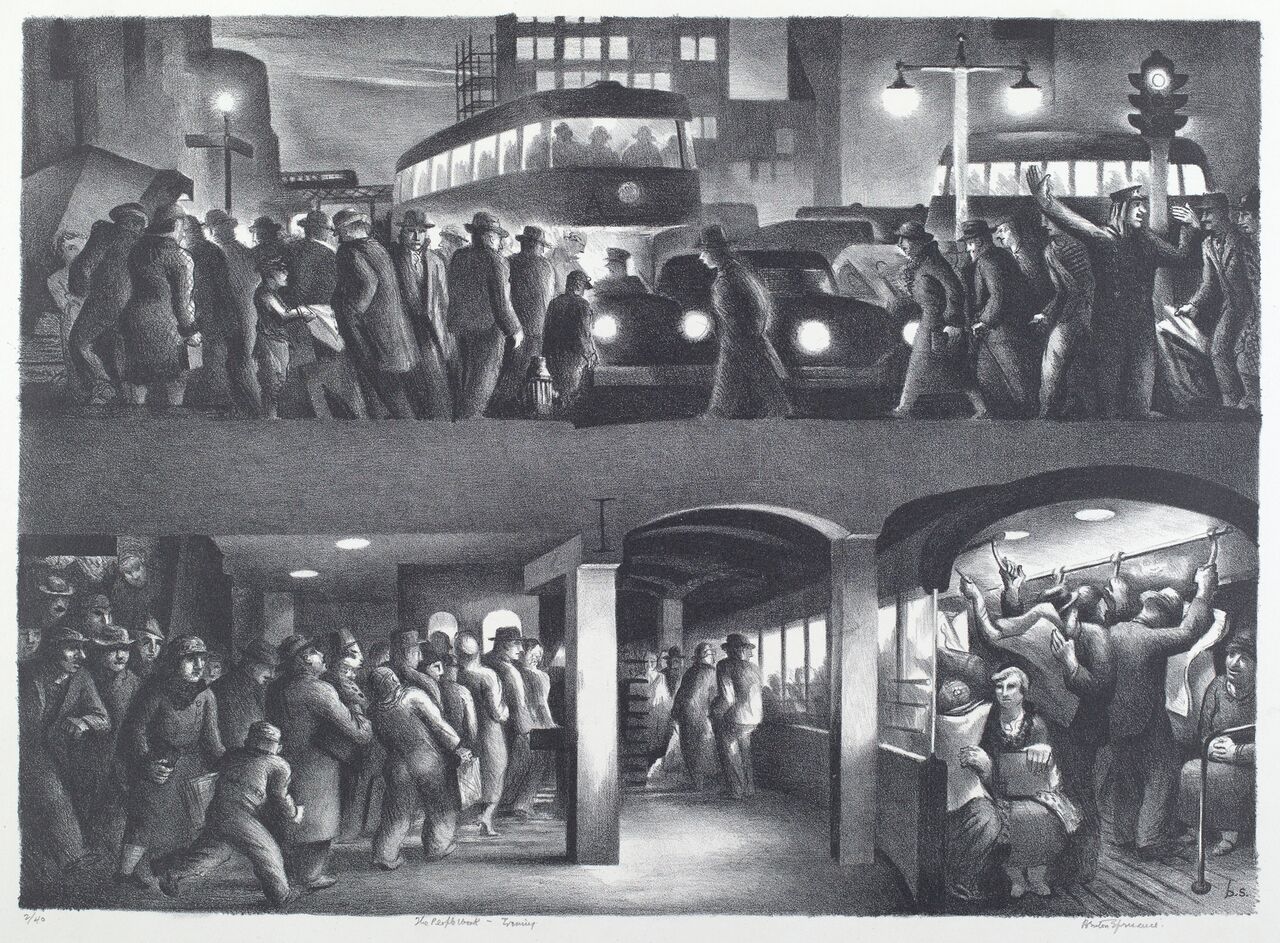 Benton Spruance, “The People Work – Evening”, 1937, lithograph, image: 34.61 x 48.26 cm (13 5/8 x 19 in.) sheet: 40.64 x 58.1 cm (16 x 22 7/8 in.) National Gallery of Art, Washington, Rosenwald Collection
Benton Spruance, “The People Work – Evening”, 1937, lithograph, image: 34.61 x 48.26 cm (13 5/8 x 19 in.) sheet: 40.64 x 58.1 cm (16 x 22 7/8 in.) National Gallery of Art, Washington, Rosenwald Collection
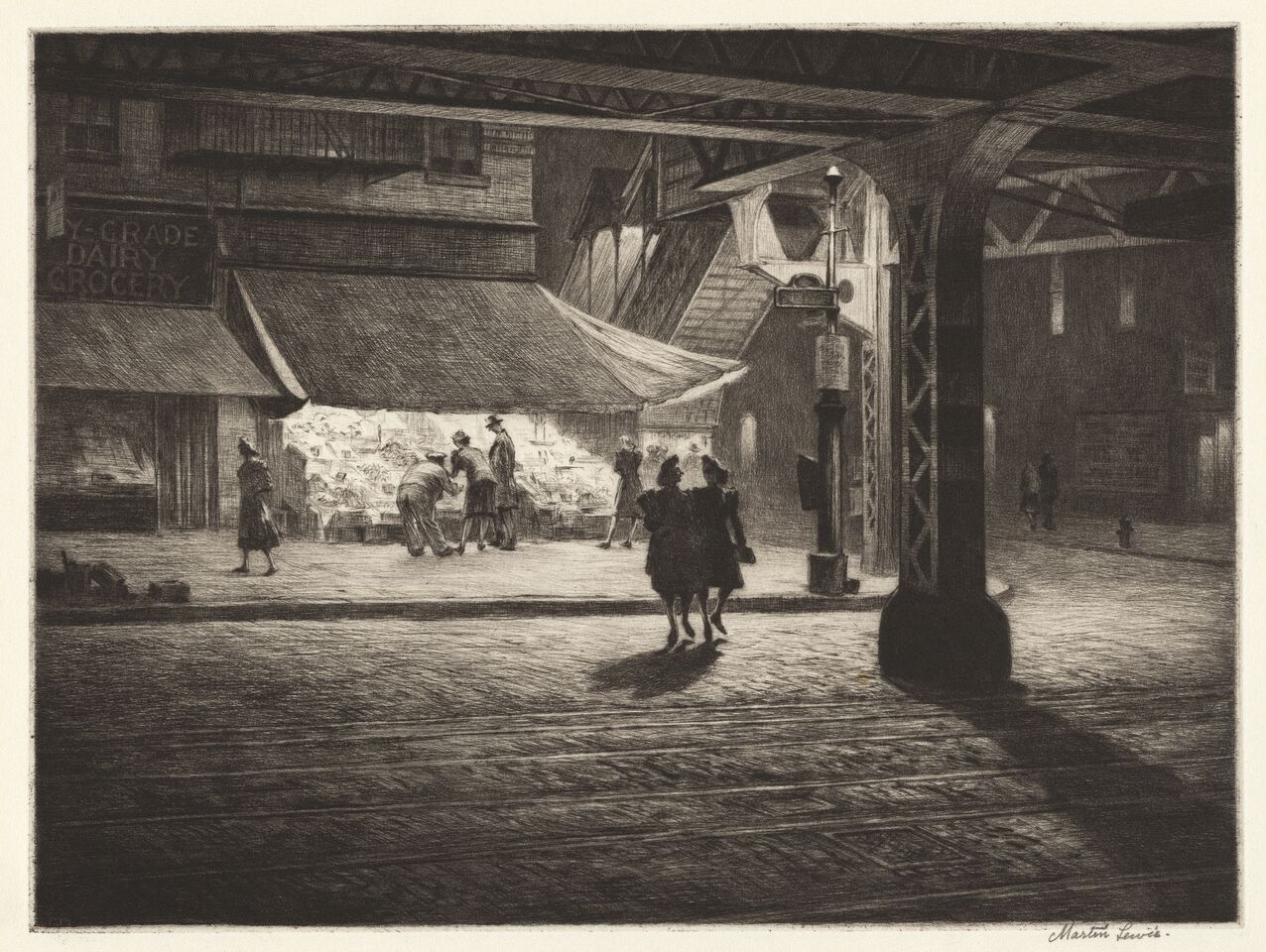 Martin Lewis, “Yorkville Night”, 1948, drypoint, sheet: 10 7/8 x 14 3/4 in. (27.62 x 37.47 cm) image: 8 1/2 x 11 1/2 in. (21.59 x 29.21 cm) National Gallery of Art, Washington, Corcoran Collection (Bequest of Frank B. Bristow)
Martin Lewis, “Yorkville Night”, 1948, drypoint, sheet: 10 7/8 x 14 3/4 in. (27.62 x 37.47 cm) image: 8 1/2 x 11 1/2 in. (21.59 x 29.21 cm) National Gallery of Art, Washington, Corcoran Collection (Bequest of Frank B. Bristow)

Isac Friedlander, “3 A.M.”, 1934, etching, plate: 24.13 x 39.69 cm (9 1/2 x 15 5/8 in.) sheet: 32.07 x 46.67 cm (12 5/8 x 18 3/8 in.) National Gallery of Art, Washington, Rosenwald Collection
 Clare Leighton, “Breadline, New York”, 1931, wood engraving, image: 29.85 x 20 cm (11 3/4 x 7 7/8 in.) sheet: 44.45 x 29.21 cm (17 1/2 x 11 1/2 in.) National Gallery of Art, Washington, Reba and Dave Williams Collection, Gift of Reba and Dave Williams
Clare Leighton, “Breadline, New York”, 1931, wood engraving, image: 29.85 x 20 cm (11 3/4 x 7 7/8 in.) sheet: 44.45 x 29.21 cm (17 1/2 x 11 1/2 in.) National Gallery of Art, Washington, Reba and Dave Williams Collection, Gift of Reba and Dave Williams
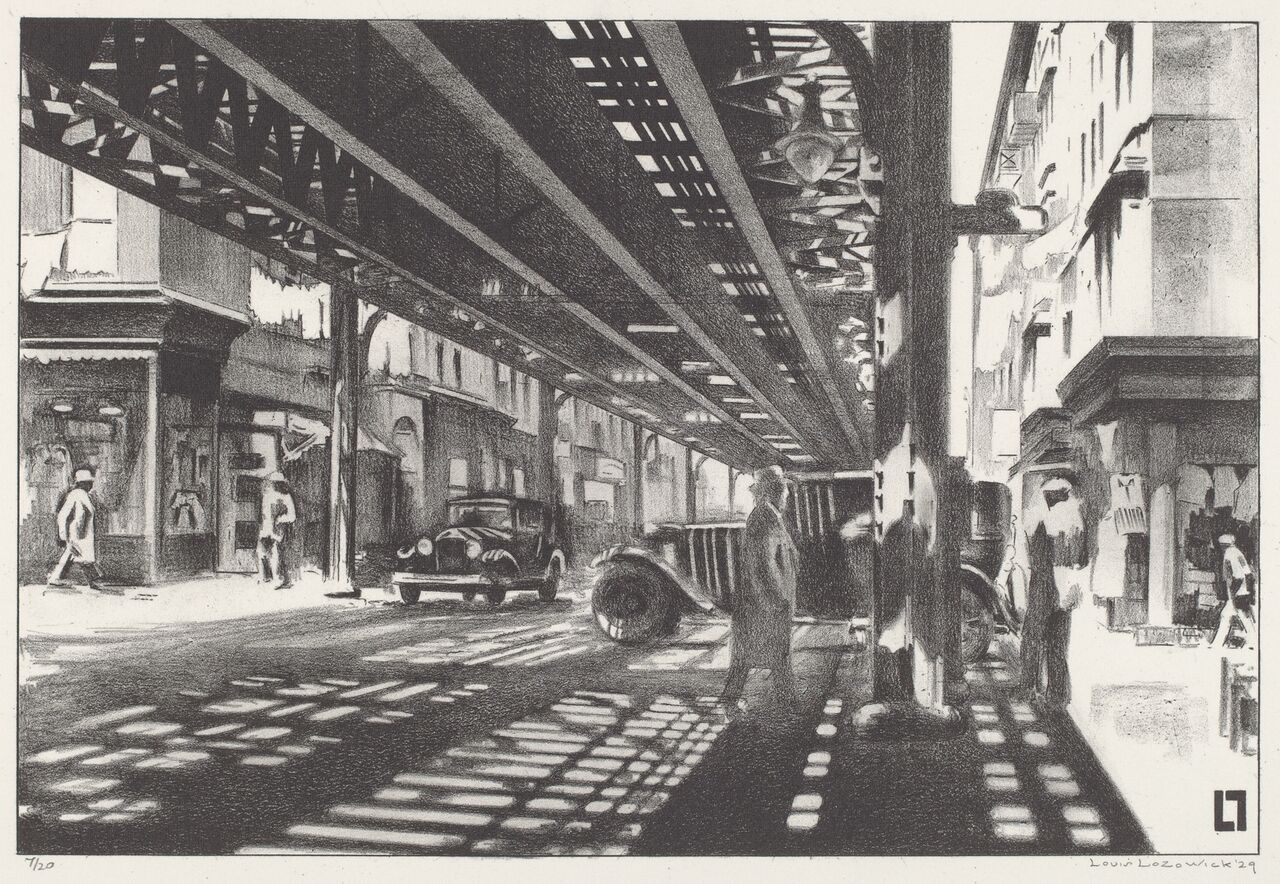 Louis Lozowick, “Allen Street”, 1929, lithograph, image: 19.1 x 28.5 cm (7 1/2 x 11 1/4 in.) sheet: 28.2 x 40 cm (11 1/8 x 15 3/4 in.) National Gallery of Art, Washington, Gift of Jacob Kainen
Louis Lozowick, “Allen Street”, 1929, lithograph, image: 19.1 x 28.5 cm (7 1/2 x 11 1/4 in.) sheet: 28.2 x 40 cm (11 1/8 x 15 3/4 in.) National Gallery of Art, Washington, Gift of Jacob Kainen
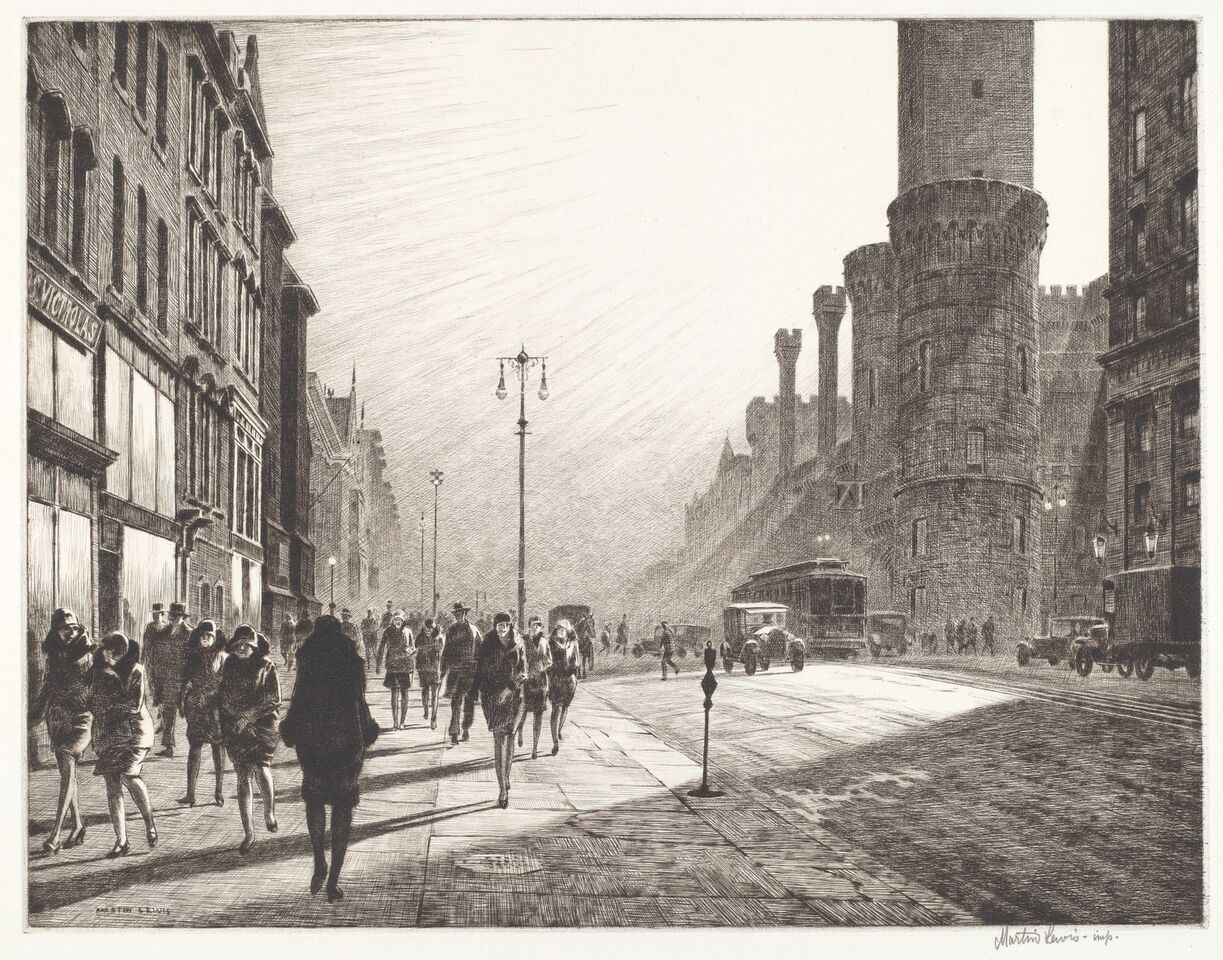 Martin Lewis, “Quarter of Nine – Saturday’s Children”, 1929, drypoint, plate: 25.1 x 32.7 cm (9 7/8 x 12 7/8 in.) sheet: 34 x 45.7 cm (13 3/8 x 18 in.) National Gallery of Art, Washington, Gift of Addie Burr Clark
Martin Lewis, “Quarter of Nine – Saturday’s Children”, 1929, drypoint, plate: 25.1 x 32.7 cm (9 7/8 x 12 7/8 in.) sheet: 34 x 45.7 cm (13 3/8 x 18 in.) National Gallery of Art, Washington, Gift of Addie Burr Clark
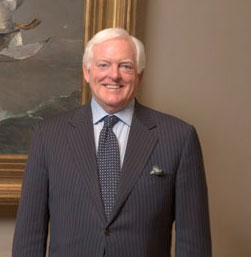 Statement
Statement
Earl A. Powell III, director, National Gallery of Art
“During the past decade the Gallery has acquired extraordinary groups of prints from the Reba and Dave Williams Collection, the Corcoran Collection, and the collection of Bob Stana and Tom Judy,”
“We are thankful for the generosity of these donors and for the opportunities that have allowed the Gallery’s American print holdings to grow in both richness and depth.”
Exhibition Organization and Support
The exhibition is organized by the National Gallery of Art, Washington.
Exhibition Curator
The exhibition is organized by Charles Ritchie, associate curator, department of American and modern prints and drawings, National Gallery of Art.
The Urban Scene: 1920–1950
25 black-and-white prints on view by recognized artists
National Gallery of Art
The National Gallery of Art and its Sculpture Garden are at all times free to the public.
They are located on the National Mall between 3rd and 9th Streets at Constitution Avenue NW,
Open Monday through Saturday from 10:00 a.m. to 5:00 p.m. and Sunday from 11:00 a.m. to 6:00 p.m.
http://www.nga.gov
